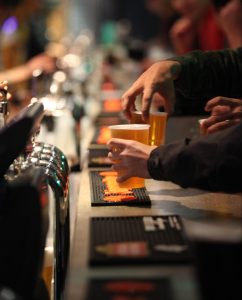PhD Insights: building a spent grain biorefinery using low-cost ionic liquids
By Priyanka Kumar a PhD student in the Department of Chemical Engineering and a member of the second Transition to Zero Pollution PhD cohort and the Science and Solutions for a Changing Planet DTP
As the urgency to phase-out fossil fuels from the energy sector increases, biorefineries, which convert sustainably grown biomass into a variety of chemicals, biomaterials and advanced biofuels are being turned to, to help address today’s global environmental and economic issues. One under-utilised biomass is Brewer’s Spent Grain (BSG), a waste biomass produced by beer breweries with a promising potential for the creation of renewable chemicals and materials, as well as protein as an additional value-added product.
More than a pint of beer

As Brits flock to beer gardens and their local pubs for their post lockdown pint, it’s no surprise that Brewer’s Spent Grain (BSG) is one of the major industrial biomass by-products in the UK. One unique feature of BSG is that it has a high protein content compared to other woody waste biomass that typically power biorefineries. However, the stubborn fibrous structure of spent grain limits its use as low-value animal feed for a few livestock species, where its nutritional value is solely in its protein. Here lies an opportunity to extract the protein in BSG to create higher-quality feed for a larger variety of animals – whilst producing bio-derived chemicals and materials from its non-protein portion. But the question is, how can such a biorefinery be developed?
The ionoSolv process
The answer (hopefully) lies in some of the work already done at Imperial. A process that has been developed in my research group, and is currently being commercialised by Imperial start-up Lixea, utilises low-cost ionic liquids for the pretreatment (i.e. fractionation) of biomass into its main components: cellulose, hemicellulose and lignin.
It is a one-size fits all process that has the ability to break down stubbornly structured plant matter, called lignocellulosic biomass. These include agricultural residues, commercial forest and wood waste. Thanks to Ionic liquids, a group of organic salts that are liquid at ambient temperatures, lignocellulosic biomass can be broken down safely with few steps and high solvent recovery, lowering the process and environmental costs typically associated with biomass pretreatment techniques. Once fractionated, the lignocellulosic biomass components can be used to make a plethora of biochemical based products: lignin-based carbon fibres, nanocellulose and other biobased composites to name a few. However, this technology is yet to be optimised for protein-rich biomass, such as BSG.
My project

Preliminary data shows that ionoSolv ionic liquids can successfully extract protein from BSG, leaving a cellulose rich fraction. The protein can be recovered in a separate fraction and has been shown to be pre-hydrolysed, making it easily digestible by the stomach. But there are steps that will need to be taken to optimise the extraction, recovery and purity of the proteins from BSG, while still maximising the quality of other components, if a successful biorefinery is to be built. My research aims to do this, with the ultimate goal of developing a biorefinery blueprint for all protein-rich biomass – not just spent grain.